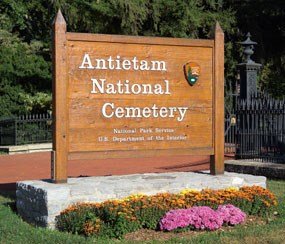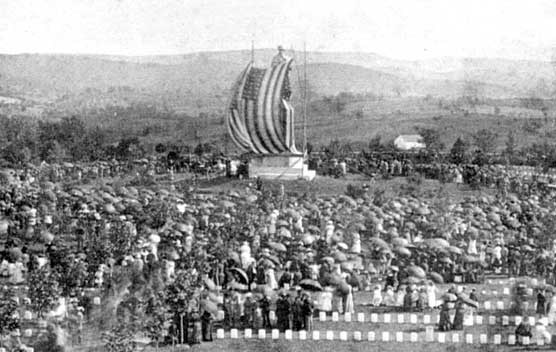
NPS OverviewAntietam National Cemetery is one of the 130 cemeteries of the National Cemetery System, a system that began during the Civil War. There are 4,776 Union remains (1,836 or 38% are unknown) buried here from the Battle of Antietam, South Mountain, Monocacy, and other action in Maryland. All of the unknowns are marked with small square stones. These stones contain the grave number, and if you look closely on a few stones, a small second number represents how many unknowns are buried in that grave. There are also a few of the larger, traditional stones that mark unknown graves. In addition, more than 200 non-Civil War dead are also buried here. Veterans and their wives from the Spanish-American War, World War I, World War II, and Korea were buried here until the cemetery closed in 1953. Recently an exception to the closure was made for the burial of Keedysville resident Patrick Howard Roy, United States Navy. Fireman Roy was killed during the attack on the USS Cole and was buried in the Cemetery on October 29, 2000. If you walk to the back of the cemetery you will notice a few separate graves. Ironically, on the battlefield that led directly to Abraham Lincoln's Emancipation Proclamation, African-American graves from WWI were segregated to this out-of-the-way corner. Cemetery map and directoryFind a graveThis sortable table can help you find a grave in the Antietam National Cemetery. Use the search bar to search for a name. You can also sort columns by clicking the triangles on the top row. If you prefer, you can download this dataset to use offline.
The "Name" column shows the names on the headstones. For any names that were spelled differently on the 1867 or 1868 lists, those variations are shown in the corresponding columns.

Library of Congress History of the Antietam National CemeteryThe first burialsThe Battle of Antietam, or Sharpsburg, on September 17, 1862, was the tragic culmination of Robert E. Lee's first invasion of the North. That one fateful day more than 23,110 men were killed, wounded, or listed as missing. Approximately 4,000 were killed, and in the days that followed, many more died of wounds or disease. The peaceful village of Sharpsburg turned into a huge hospital and burial ground extending for miles in all directions. Burial details performed their grisly task with speed, but not great care. Graves ranged from single burials to long, shallow trenches accommodating hundreds. For example, William Roulette, whose farm still stands behind the Visitor Center today, had over 700 soldiers buried on his property. Grave markings were somewhat haphazard, from stone piles to rough-hewn crosses and wooden headboards. A few ended up in area church cemeteries. In other cases, friends or relatives removed bodies from the area for transport home. By March of 1864, no effort had been made to find a suitable final resting place for those buried in the fields surrounding Sharpsburg. Many graves had become exposed. Something had to be done. Establishing a PlanIn 1864, State Senator Lewis P. Firey introduced to the Maryland Senate a plan to establish a state, or national, cemetery for the men who died in the Maryland Campaign of 1862. On March 23, 1865, the state established a burial site by purchasing 11¼ acres for $1,161.75. The original Cemetery Commission's plan allowed for burial of soldiers from both sides. However, the rancor and bitterness over the recently completed conflict and the devastated South's inability to raise funds to join in such a venture persuaded Maryland to recant. Consequently, only Union dead are interred here. Confederate remains were re-interred in Washington Confederate Cemetery in Hagerstown, Maryland; Mt. Olivet Cemetery in Frederick, Maryland; and Elmwood Cemetery in Shepherdstown, West Virginia. Approximately 2,800 Southerners are buried in these three cemeteries, over 60% of whom are unknown. An Arduous TaskIn an effort to locate grave sites and identify the occupants, no one was of more value than two area men: Aaron Good and Joseph Gill. In the days, months, and years following the battle, these men freely gave of their time and gathered a large number of names and burial locations. The valuable service provided by these men cannot be overstated. The dead were identified by letters, receipts, diaries, photographs, marks on belts or cartridge boxes, and by interviewing relatives and survivors. Contributions totaling over $70,000 were submitted from 18 Northern states to the administrators of the Antietam National Cemetery Board. With a workforce consisting primarily of honorably discharged soldiers, the cemetery was completed by September 1867. In the spring of 2020, a burial map of the Antietam Battlefield was discovered in the New York Public Library. 
NPS DedicationOn September 17, 1867, on the fifth anniversary of the battle, the cemetery was ready for the dedication ceremonies. The ceremony was important enough to bring President Andrew Johnson and other dignitaries. President Johnson proclaimed, "When we look on yon battlefield, I think of the brave men who fell in the fierce struggle of battle, and who sleep silent in their graves. Yes, many of them sleep in silence and peace within this beautiful enclosure after the earnest conflict has ceased." 
NPS Private Soldier MonumentThe colossal structure of granite standing in the center of the cemetery reaches skyward 44 feet-7 inches, weighs 250 tons, and is made up of 27 pieces. The soldier, made of two pieces joined at the waist, depicts a Union infantryman standing "in place rest" facing homeward to the north. The soldier itself is 21½ feet tall and weighs about 30 tons. Designed by James G. Batterson of Hartford, CT, and sculpted by James Pollette of Westerly, RI, for a cost of over $32,000, the "Private Soldier" first stood at the gateway of the Centennial Exposition in Philadelphia, PA, in 1876. It was disassembled again for the long journey to Sharpsburg. On September 17, 1880, the statue was finally in place where it was formally dedicated. The journey of "Old Simon," as he is known locally, had been delayed for several months when the section from the waist up fell into the river at Washington, D.C. When retrieved, it was transported on the C&O Canal, and dragged by using huge, wooden rollers through Sharpsburg to the cemetery. The inscription on the monument reads, "Not for themselves, but for their country." Veteran SuperintendentGeorge Fisher was the last Civil War veteran to hold the postion of Superintendent of the Antietam National Cemetery. He was from Hagerstown, Maryland and had quite a distiguished career. 
NPS | |||||||||||
Last updated: December 21, 2025

